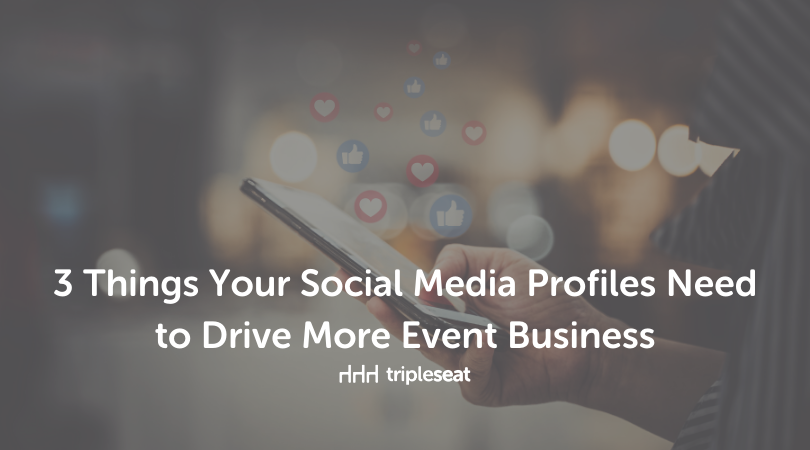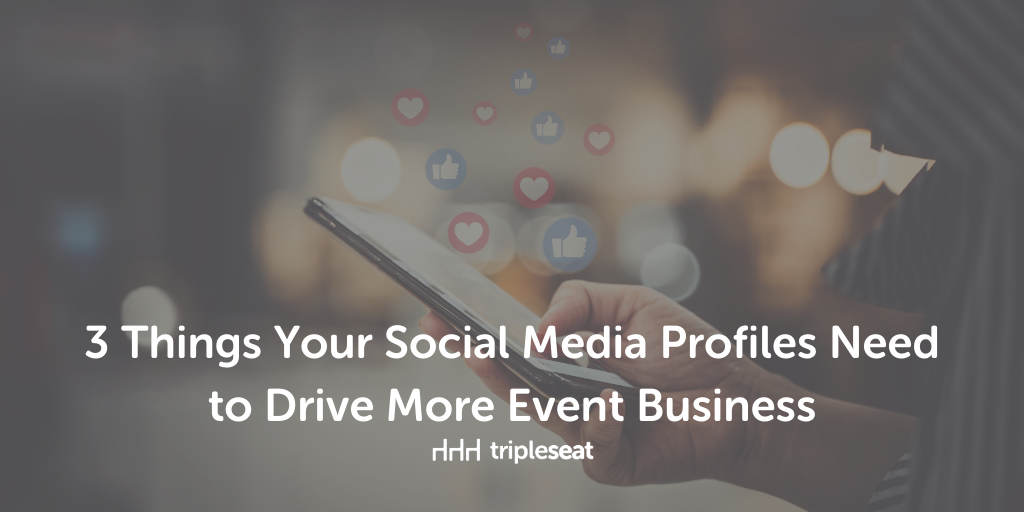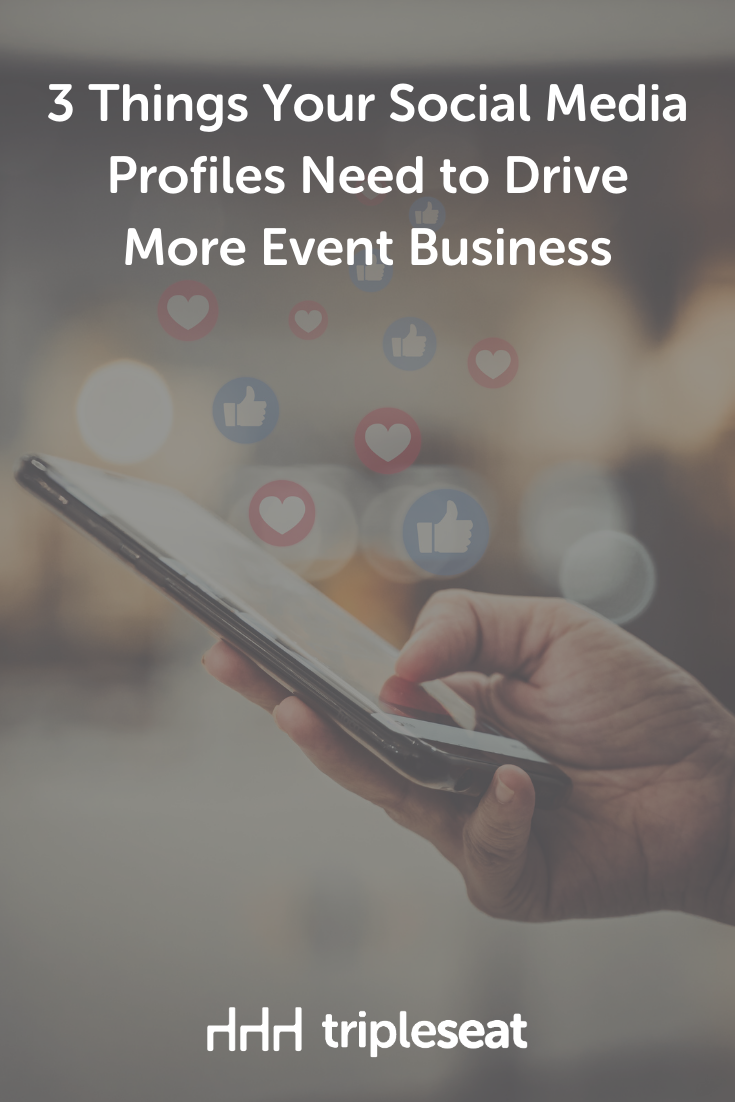3 Things Your Social Media Profiles Need to Drive More Event Business

Everything consumers are looking for about a business is accessible online or on a phone app these days, making the social media presence of businesses a crucial factor in their marketing and sales initiatives. The rise in social media makes an online presence no only important, but also a key reason why many businesses are found at all.
When it comes to setting up a new profile, editing current profile information, or understanding how to post to your advantage, there are a few things to keep in mind. By following these ideas, restaurants and venues can amplify the power of social media as a way to attract a la carte dining and events business to their locations.
1. Start with the basics
The basic steps to setting up any social media account, whether it be Instagram, Twitter, Facebook, Pinterest, LinkedIn, YouTube, and so on, include providing the platform with the basic information about your restaurant or venue. The typical information you would list is your business name, profile photo or logo, address, a description about your restaurant, and contact info at the very least. Stay consistent when it comes to the business name/social media profile handle and profile photo or logo by using the same ones across your restaurant’s various social media accounts.
It has also become important throughout COVID-19 to include basic information in your description about your restaurant’s hours, dine-in, catering, takeout, and delivery options. On your restaurant’s Instagram profile, you may include a link in the profile bio that could lead to your website, menu, or directly to your Tripleseat lead form. On Facebook, you also can set up various features such as a 360 view, community page, or a direct call to action button that links to your Tripleseat lead form. Regardless of the platform, make sure most of the basic information about your venue can be located on your profile.
2. Consistent activity
In order to drive more business to your social media accounts, you have to stay active by posting regularly. This may be every day for some venues, three times a week, or once a week, depending on how much time you can designate to maintaining the social media accounts. Regardless, it is important to show that your restaurant or venue is up and running, especially through COVID-19 when many restaurants have moved to different hours or closed down.
The first place that many diners look — even before a restaurant’s website — is the business’ Instagram account in order to see the most recent updates. Post regularly with food photos, menu updates, virtual events, staff photos, safety changes, and notable customer experiences so that your audience knows that you are ready to welcome them back however you are offering. It is also easy to share an Instagram post to Facebook or Twitter by linking the accounts, and clicking share to those accounts when making the post.
3. Use the unique features of each platform
Make sure that you make the most of how you use each social media platform because they all work a little bit differently. Facebook allows business pages to highlight reviews, which is a unique feature that the other platforms do not offer. Encourage guests to write Facebook reviews by promoting your page on social media, on receipts, or on tables at the restaurant. Some businesses even run entire social media campaigns around getting reviews for their Facebook page and award prizes to those who review. A great review can go a long way to drive new business!
On Instagram, be sure to use Instagram stories to post quick pics and videos, or re-post content by customers who tag your restaurant. Also, be sure to like comments and comment back to anyone engaging with you on Instagram because the platform’s algorithm will reward you for engaging with your audience.
On Pinterest, take advantage of building as many boards as your business may need, and re-pinning other users’ posts to show engagement. Pinterest is a great place for a wedding venue to be active and posting wedding content — 40 million people a year use Pinterest to plan their wedding. Brides-to-be could stumble across your venue photos or wedding day tips and take interest in you from your Pinterest presence alone. Get found by using the word “wedding” and other related keywords in relevant board titles, pin titles, and pin descriptions.
If your restaurant or venue is on Twitter, you have the opportunity to post smaller blurbs of text or else link to bigger pieces of content that you have created yourself or that have featured your restaurant. Twitter could be a great way to stay active and engaged with industry information, holidays, and trends as well. Twitter is often a more casual platform, and brands can engage with other accounts through casual conversation by tweeting back and forth. Use Twitter’s Explore tab to find topics and hashtags that are trending and use those hashtags in your tweets — only if the content is relevant — to get in front of more people and to be a part of the bigger conversation.
When it comes to LinkedIn, YouTube or even TikTok, your restaurant or venue may not be there quite yet or even have an interest in going to those platforms. It’s OK not to use every single social media platform, because focusing on quality content on select platforms is better than getting on every platform simply because you think you should.
LinkedIn could be used to post about your brand, industry topics, and has a section for job opportunities. YouTube is great for hosting long videos, such as an in-depth behind the scenes video with a top chef to make a meal. TikTok on the other hand, is great for quick videos, like how to make a cocktail the way your star bartender does. Every social media platform offers something a little different, and your restaurant or venue can use the features however they work best for you.
More resources
Now that you know the basics about what your restaurant or venue’s social media profiles should look like, it is time to dive deeper into the content that gets posted. Check out this blog post to learn more about what photos and videos to share on social media in order to drive events business. You can also download our Events Industry Handbook, The Event Professional’s Guide to Creating a Marketing Plan, to help you take a good look at your marketing activity and make some crucial changes that will help you drive more business.


